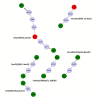A dynamic co-expression approach reveals Gins2 as a potential upstream modulator of HNSCC metastasis
- PMID: 39865116
- PMCID: PMC11770085
- DOI: 10.1038/s41598-024-82668-1
A dynamic co-expression approach reveals Gins2 as a potential upstream modulator of HNSCC metastasis
Abstract
Head and neck squamous cell carcinoma (HNSCC) is an aggressive cancer that is notably associated with a high risk of lymph node metastasis, a major cause of cancer mortality. Current therapeutic options remain limited to surgery supplemented by radio- or chemotherapy; however, these interventions often result in high-grade toxicities. Distant metastasis significantly contributed to the poor prognosis and decreased survival rates. However, the underlying molecular mechanisms remain poorly understood. Disease-related "omics" data provide a comprehensive overview of gene relationships, helping to decode the complex molecular mechanisms involved. Interactions between biological molecules are complex and highly dynamic across various cellular conditions, making traditional co-expression methods inadequate for understanding these intricate relationships. In the present study, a novel three-way interaction approach was employed to uncover dynamic co-expression relationships underlying the metastatic nature of HNSCC. Subsequently, the biologically relevant triples from statistically significant ones were defined through gene set enrichment analysis and reconstruction of the gene regulatory network. Finally, the validity of biologically relevant triplets was assessed at the protein level. The results highlighted the "PI3K/AKT/mTOR (PAM) signaling pathway" as a disrupted pathway involved in the metastatic nature of HNSCC. Notably, Gins2, identified as a switch gene, along with the gene pair {Akt2, Anxa2}, formed a statistically significant and biologically relevant triplet. It suggests that Gins2 could serve as a potential upstream modulator in the PAM signaling pathway, playing a crucial role in the distant metastasis of HNSCC. In addition, survival analysis of significant switch genes indicated that two genes, C19orf33 and Usp13, may be especially important for prognostic purposes in HNSCC.
Keywords: Head and neck squamous cell carcinoma; Liquid association method; Metastasis.
© 2024. The Author(s).
Conflict of interest statement
Declarations. Competing interests: The authors declare no competing interests.
Figures







Similar articles
-
IGF2BP1 promotes the progression of head and neck squamous cell carcinoma by activating PI3K/AKT/mTOR signaling pathway and inducing epithelial-mesenchymal transition.World J Surg Oncol. 2025 Jul 14;23(1):277. doi: 10.1186/s12957-025-03929-5. World J Surg Oncol. 2025. PMID: 40660234 Free PMC article.
-
MRPL21-PARP1 axis promotes cisplatin resistance in head and neck squamous cell carcinoma by inhibiting autophagy through the PI3K/AKT/mTOR signaling pathway.J Exp Clin Cancer Res. 2025 Jul 26;44(1):221. doi: 10.1186/s13046-025-03482-9. J Exp Clin Cancer Res. 2025. PMID: 40713706 Free PMC article.
-
Single-Cell Molecular Profiling of Head and Neck Squamous Cell Carcinoma Reveals Five Dysregulated Signaling Pathways Associated With Circulating Tumor Cells.Cancer Control. 2024 Jan-Dec;31:10732748241251571. doi: 10.1177/10732748241251571. Cancer Control. 2024. PMID: 38869038 Free PMC article.
-
Systemic pharmacological treatments for chronic plaque psoriasis: a network meta-analysis.Cochrane Database Syst Rev. 2017 Dec 22;12(12):CD011535. doi: 10.1002/14651858.CD011535.pub2. Cochrane Database Syst Rev. 2017. Update in: Cochrane Database Syst Rev. 2020 Jan 9;1:CD011535. doi: 10.1002/14651858.CD011535.pub3. PMID: 29271481 Free PMC article. Updated.
-
Systemic pharmacological treatments for chronic plaque psoriasis: a network meta-analysis.Cochrane Database Syst Rev. 2021 Apr 19;4(4):CD011535. doi: 10.1002/14651858.CD011535.pub4. Cochrane Database Syst Rev. 2021. Update in: Cochrane Database Syst Rev. 2022 May 23;5:CD011535. doi: 10.1002/14651858.CD011535.pub5. PMID: 33871055 Free PMC article. Updated.
References
-
- Bray, F. et al. Global cancer statistics 2018: GLOBOCAN estimates of incidence and mortality worldwide for 36 cancers in 185 countries. CA Cancer J. Clin.68(6), 394–424 (2018). - PubMed
-
- Marur, S. & Forastiere, A. A. Head and neck cancer: Changing epidemiology, diagnosis, and treatment. In Mayo Clinic Proceedings (Elsevier, 2008). - PubMed
-
- Shimizu, S. et al. Identification of a novel therapeutic target for head and neck squamous cell carcinomas: A role for the neurotensin-neurotensin receptor 1 oncogenic signaling pathway. Int. J. Cancer. 123(8), 1816–1823 (2008). - PubMed
-
- de la Fuente, A. From ‘differential expression’to ‘differential networking’–identification of dysfunctional regulatory networks in diseases. Trends Genet.26(7), 326–333 (2010). - PubMed
MeSH terms
Substances
LinkOut - more resources
Full Text Sources
Medical
Miscellaneous

